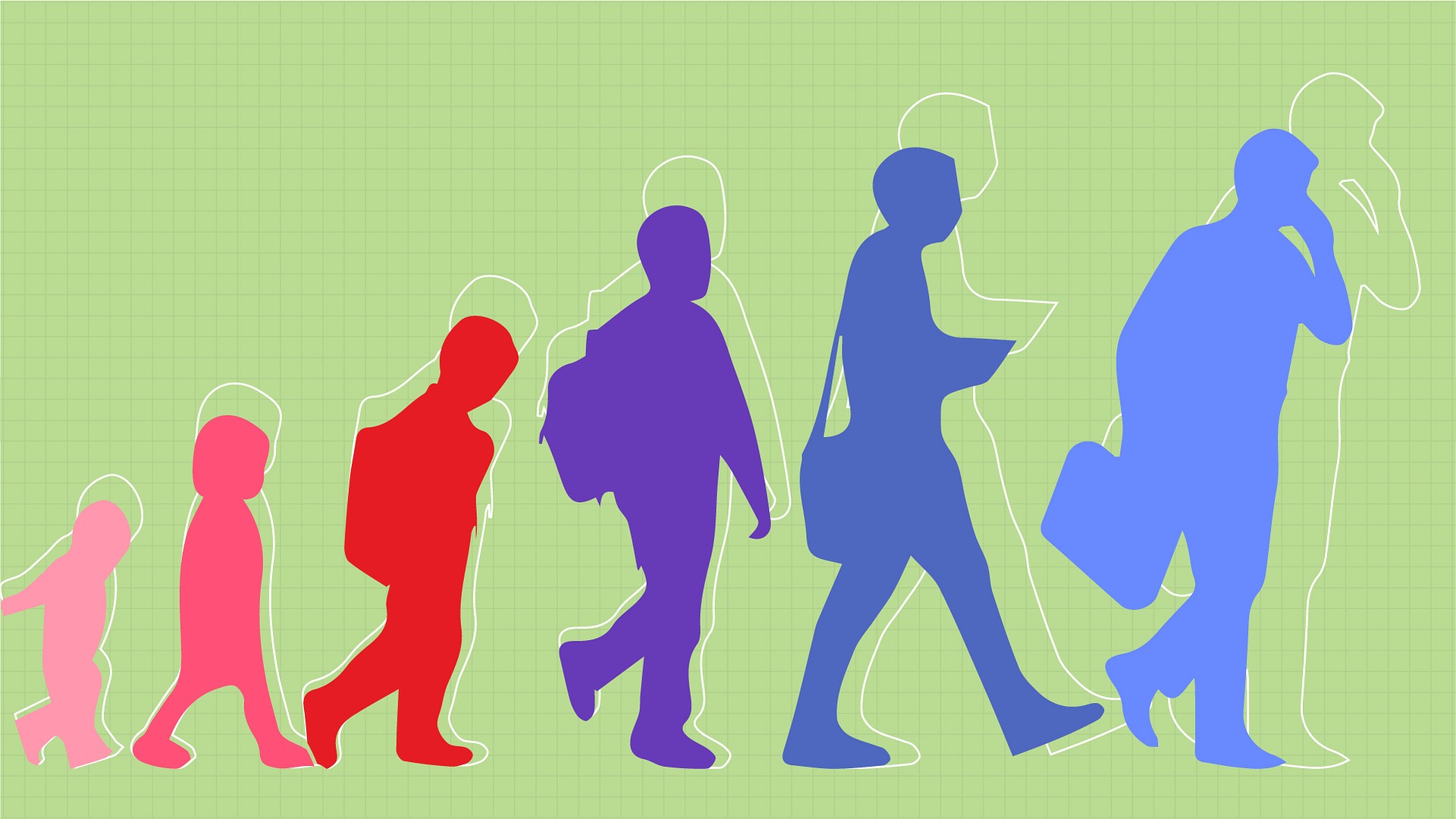PRINCIPLES OF HUMAN GROWTH AND DEVEOPMENT
There is a set of principles that characteristic the pattern and process of growth and development. These principles or characteristics describe typical development as a predictable and orderly process, that is, we can predict how more children will develop and that they will develop at the same rate and at about the same time as other children. Although there are individual differences in children’s person abilities, activity levels and timing of developmental milestones, such as ages and stages, the principles and characteristics of development are universal patterns.
 source
source
The principles are as follows:
Development proceeds from the head downwards
This is called the CEPHALOCAUDAL principle. This principle describe the direction of growth and development. According to this principles, the child gains control of the head first, then the arms, and then the legs. Infant develop control of the head and face movements within the first two months after births. In the next few months, they are able to lift themselves up by using their arms. By 6 to 12months of age, infants starts to gain leg control and may be able to crawl, stand, or walk. Coordination of arms always precedes coordination of legs.
Development proceeds from the centre of the body outwards
This is the principle of proximodorsal development that also describes the direction of development. This means that the spinal cord develops before outer part of the body. The Childs arms develop before the hands and the hands and feet develop before the fingers and toes. Finger and toe muscles (used in fine motor dexterity) are the last of develop in physical development.
Development depends on maturation and learning:
Maturation refers to the sequential characteristics of biological growth and development. The biological changes occurs in sequential order and give children new abilities. Changes in the brain and nervous system help children to improve in thinking (cognitive) and motor (physical) skills. Also, children must mature to a certain point before they can progress to new skills (readiness). For example, a four month old cannot use language because the infant’s brain has not matured enough to allow the child to talk. By two years old, the brain has developed further and with heap from others, the child will have the capacity to say and understand words.
Also, a child can’t write or draw until he has developed the motor control to hold a pencil or crayon. Maturational pattern are innate, that is, genetically programmed. The child’s environment and the learning that occurs as a result of the child’s experience largely determine whether the child will reach optional development. A stimulating environment and varied experiences allow a child to develop to his or her potential.
Development proceeds from the simple (Concrete) to the mora complex
Children use their cognitive and language skills to reason and solve problems. For example, learning relationships between things and how things are similar), or classification is an important ability in cognitive development. The cognitive process of learning how an apple and orange are alike begins with the most simplistic or concrete though of describing the two. Seeing no relationship, a preschools child will describe the objects according yo some property of the object, such as color, such a response would be, “An apple is red (or green) an orange is orange. The first level of thinking about how objects ate alike is to give a descriptions or functional relationship (both concrete thoughts) between the two objects. “An apple and orange are rounds” and an apple and orange are alike because you eat them” are typical responses of three, four and years olds.
As children develop further in cognitive skills, they are able to understand a higher and more complex relationship between objects and things: this is, that an apple and orange exist in a class called FRUIT. The child cognitively is then capable of classification.
 source
source
Growth and development is a continuous process
As a child develops, he/she adds to the skills already acquired and the new skills become the basis for further achievement and mastery of skills. Most children follow a similar pattern.
Also, one stage of development lays the foundation for the next stage of development for example, in motor development, there is predictable sequence of development that occur before walking. The infant lifts and turns the head before he or she can turn over. Infants can move their limbs (arms and legs) before grasping an object. Mastery of climbing stairs involves increasing skills from holding onto walking alone. By the age of four, most children can walk up and down stairs with alternating feet. As in maturation, in order for children to write or draw, they must have developed the manual (hand) control to hold a pencil and crayon.
Growth and development proceed from the general to specific
In motor development, the infant will be able to grasp an object with the whole hand before using only the thumb and forefinger. The infant’s first motor movements are very generalized, undirected, and reflexive, waving arms or kicking before being able to reach or creep toward an object. Growth occurs from large muscle movement to more refined (smaller) muscle movements.
There are individual rates of growth and development:
Each child’s different and the rates at which individual children grow is different/ although the patterns and sequence for growth and development are usually the same for all children, the rate at which individual children reach developmental stages will be different.
Understanding this fact of individual differences, in rates of development should cause us to be careful about using and relying on age and stage characteristic to describe or label children. There is a range of ages for any developmental task to take place. This dismisses the notion of the “average child” some children will walk at ten months while others walks a few months older at eighteen month of age. Some children are more active while others are more passive. This does not means that the passive child will be less intelligent as an adult. There is no validity to comparing one child’s progress with or against another child. Rates of development also are not uniform within an individual child. For example, a child’s intellectual development may progress faster than his emotional or social development. An understanding of the principles of development helps us to plan appropriate activities and stimulating and enriching experiences for children, and provides a basis for understanding how to encourage and support young children’s learning.
Child’s Growth and Development
The period of childhood is the formative years when most things that later happen in future are determined. The events of this period play very important role in shaping the future of any child. Parents, teachers, advocates, instructors need to know and understand the formative years of children because of the following reasons:
- This will help him have a good understanding of the young ones.
- He plays an important role in shaping a child’s future development (life)
- He may have to work with a child whose early development has been disturbed and who will need skillful help and guidance to overcome his difficulties
By the time a child is born, he is already a product of genetic as well as environmental factors. According to Ausubel (1957), the period of childhood can be divided into five stages, namely;
- The neonatal period from birth to about 4weeks
- Infancy – 4 weeks to 2years
- Pre-school period 2 to 6years
- Middle childhood – 6 to 9years
- Pre-adolescence – 9 years to puberty
The basic biological needs of every human being are: food, air, water (liquid), activity (exercise) and rest (sleep). But in addition, everybody skill requires certain social or personality needs. These are otherwise known as sociogenic or learned needs. It is doubtful if any child can developed properly or learn effectively if his personality needs are disregarded. It is therefore ensure that classroom activities agree with these sociogenic needs of the children. These needs include the following.
Need for security:
Every child wants thins to be regularly and stable for him in his daily activity. Not to be sure as to how they stand in their group or having anxiety as to whether they will pass or fail a course can destabilize their life.
Need for affection
Everybody wants love. There is a popular saying that: To love is nothing, to be loved is something but to love and be loved is everything. A good and responsible parents is the one who genuinely loves his children. A child destabilized when he sees sign of haltered from his teacher/parents.
Need for status
Every child needs recognition and attention. He will therefore be happy if his teacher, parent or peers recognize him and attend to him while performing.
Need for freedom or independence
Children mostly by limitation therefore, there is always that desire in them to want to behave like adults. Children (adolescents, in particular) want to take responsibility. It is therefore necessary for teacher or parents to give.
Need for competence
Children like to be competent at doing things. No wonders why the brilliants (serious) ones will not like to miss anything in their mathematical calculation. In lost cases they look for what can stimulate them from the environment and they are happy when they can control the desired situation. All that such children need are encouragement and supervision.
Finally, adults should let the children have sense of belonging in the home or class or society they belong. They should be made to be part and parcel of the environment.
MATURATION AND LAERNING
Maturation plays an important role in child development. Maturation is the gradual unfolding of inborn characteristics that are common to the species. It is usually independent of experience and learning. Phylogenetic functions depend mainly on maturation while ontogenetic functions depend on training and experience.
The two major conditions necessary for maturation to take place are: good nutrition and good health. The maturational development of language in a child proceeds from production of meaningless sounds, then to the production of words and later to that of sentences. However, it is important that one should allow the operation base in a child to develop on its own. To ask/force a child to take up a function prematurely may do more harm than good. At an early stage, a child is unable to hold his head up without his mother supporting the head with her heads. But as he grows up to a stage he is able to hold the head without the mother’s support. The same things goes with a child’s ability to talk and walk.
Learning is another principle that plays a major role in child development learning is a relatively permanent change in behaviour as a result of experience and training.
Behaviour have may be physical (psychomotor, intellectual, cognitive, or emotional affective). Learning must not be something resulting from ingestion of drugs or from injury. Ontogenetic function such as ability to read a book or speak in English language and ability to ride a bicycle or drive a car are all the due to learning. Nobody ever grew up with any of these abilities without training or experience.
In addition, most aspect of child’s development are result from interaction between maturation and learning. Many of the ontogenetic functions in a child depend on the level of maturation. For example, a child cannot understand the technique of car-driving unless he attains a particular level of maturity. Consequent upon the interrelationship between maturation and learning, there is always a minimum age which any child can go into the school system in any country (four years, in most cases). Similarly when a child gets into the school, he is not expected to spend less or more than a year in a class so that his age will always correspond to his class each year. This is, of course, under normal circumstance. It is not easy, for instance in Nigeria, for a four year-old child to understand what are being taught in primary three. One expects him to be about 8years of age before getting to that class.

Too much informative sir 👍👍 thanks for sharing..
my pleasure sir. I hope you have picked something from it.